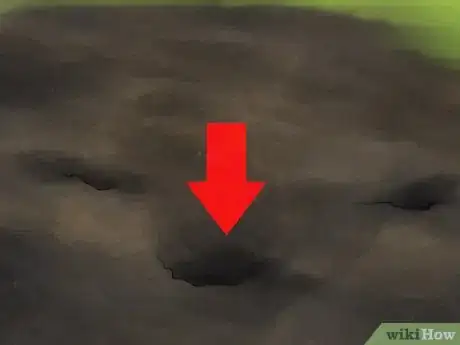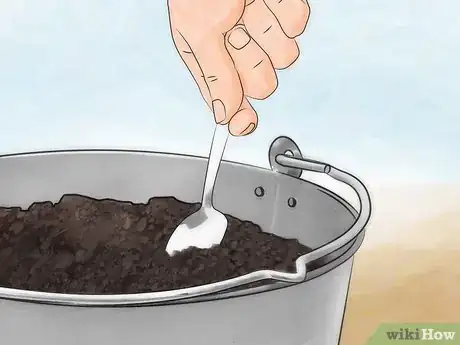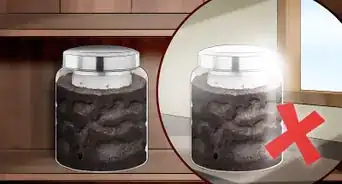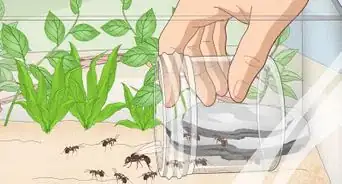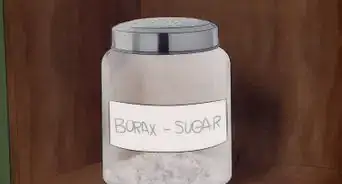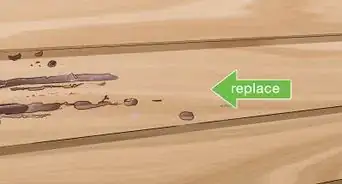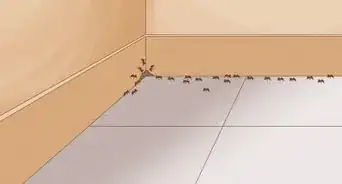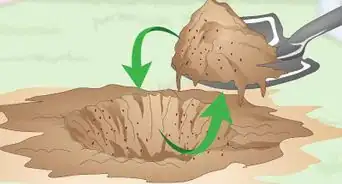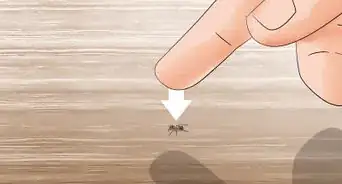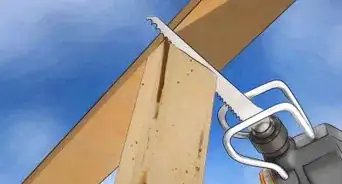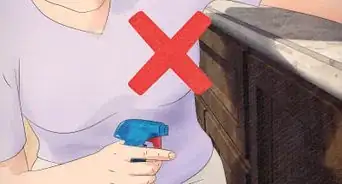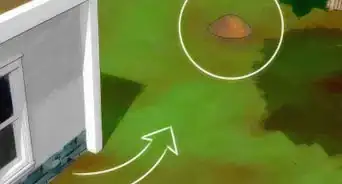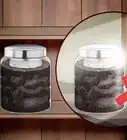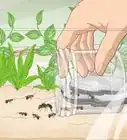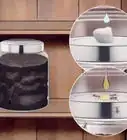This article was co-authored by Shweta Sharma. Shweta Sharma is a Biologist with the U.S. Environmental Protection Agency (EPA). With nearly ten years of experience, she specializes in insect management, integrated pest management, insect behavior, resistance management, ecology, and biological control. She earned her PhD in Urban Entomology and her MS in Environmental Horticulture from the University of Florida. She also holds a BS in Agriculture from the Institute of Agriculture and Animal Sciences, Nepal.
wikiHow marks an article as reader-approved once it receives enough positive feedback. In this case, several readers have written to tell us that this article was helpful to them, earning it our reader-approved status.
This article has been viewed 247,054 times.
Finding a queen ant is the first step to building your very own ant farm. Queen ants can be quite elusive, but if you know what you’re looking for and how to look, then you can catch your own queen ant with some time and patience.
Steps
Waiting for a Queen Ant to Start a New Colony
-
1Contact an expert about the best time. Queen ants in existing colonies will venture off to start new colonies during certain times of the year.[1] Local entomologists (people who study insects) or even local pest control companies will likely know the best time of year for you to search for a queen ant venturing off to build a new colony.
- Day length, temperature, and rainfall are just a few of the variables to take into consideration for your area regarding when a queen will do this. For dryer areas such as the Southwest, it will usually be in the springtime, whereas later summer monsoons may be the ideal time in other regions.[2]
-
2Find an area with several active ant colonies. The more ant colonies you check during the correct window of opportunity, the more likely you will be to find a queen ant during her search. A queen is also likely to try to build a colony in an area where other ant colonies already thrive, so look for spots in undeveloped areas with several colonies within a short distance of one another.[3]Advertisement
-
3Look for a queen ant. Queen ants and the males that mate with them don’t simply fly out of the mature colony entrance knowing where to go. During the correct window, you might see several queen ants walking around near the entrance to their parent colony. During this period, the queen ants are testing the weather to decide on the right time to start a new colony.[4]
- Since you're looking for a queen ant, you should know how to differentiate them from the other ants in the colony. At this stage, the queen ant will have wings. However, even after the stage where she pulls off her wings, you can identify her by her much larger size compared to the other ants.v This will be most prominent in the thorax, which is the middle section of the ant between the head and the abdomen of the ant. You can also find additional characteristics provided at: How to Identify a Queen Ant
- If you simply want a queen ant, this is the ideal time to cup one; however, if you want a queen ant in order to start your own ant colony, then you shouldn’t do it yet. These still winged queen ants have not yet mated in this step of colony building.[5]
-
4Wait until you see a queen ant wandering around erratically. Once a queen mates, she will look for the new colony location. In contrast to the fairly oriented paths of most ants, the queen ant will wander around checking cracks and crevices, changing directions, and generally resembling a lost tourist in a big city.[6] Her erratic behavior simply means she’s looking for the ideal spot to begin her new colony.
- Another sign that a queen ant has already mated is when she has pulled off her wings.[7] Once she picks a general area, she will pull off her wings in order to appear less conspicuous. She will still walk around trying to find the perfect location in her chosen area, though.
-
5Handle your new queen ant with care. Once she has pulled off her wings, it’s much easier to catch a queen ant, but make sure you handle her gently. If you want to transport your queen ant to make a personal ant farm, a film canister works well. Make sure she gets plenty of water by placing a damp cotton ball inside the canister as well.[8]
- The best option is to create a test tube setup. You need a test tube, cotton balls, and water. Fill the test tube 1/2 full with water. Push a cotton ball down to block off the water. Make sure the cotton is not soaking wet. Put the queen in the tube and block off the entrance with some cotton. You now have a standard test tube setup.[9]
Digging to Find a Queen Ant
-
1(Note: The former method is a more sustainable way to go about finding a queen ant. In this method you risk injuring/killing the queen) Use a spade to cut a trench around the ant colony. This method will require more work but less expert timing. Begin by using a spade to cut a 6-8” radius trench around the entrance of the ant hill.
-
2Use a large spade to dig out the colony. Once you finish creating the trench, start shoveling out the area inside the trench, which will be comprised of the majority of the ant colony.
-
3Shovel the soil into five-gallon buckets. You will need to dig up quite a bit of ground to reach all the various chambers of the colony, so keep two five-gallon buckets on hand and shovel the soil into them.
- Try to keep the clumps of earth as intact as possible so as not to collapse every tunnel as you dig the colony out.
- You also want to make sure that you cover each bucket as you will it to stop any queens from potentially escaping.
- If you use this method on a brand new colony where the queen has just mated and is still digging out her nest, then you won’t have to dig very far, and you won’t have much to sift through to find her.[10] Telltale signs for this type of brand new colony include a very small entrance hole with a small heap of fresh dirt beside it that hasn’t yet been formed into a mound.[11]
-
4Follow chambers and tunnels where possible. They can be hard to identify while working quickly, but you should especially follow chambers and tunnels in the soil as you dig out the colony. Keep collecting samples until you see very few ants left in the hole.[12]
-
5Sort through the buckets. Once you have collected the colony, you will have to sort through the buckets manually to find the queen. Use a spoon to sift through the dirt and separate ants.[13]
- You may want to transfer the ants into smaller jars as you separate them and the soil.
- For obvious reasons, you probably don’t want to do this inside your house.
-
6Locate the queen. It will be a painstaking process, but you should eventually locate the queen as you go through the colony. If you are unsure of what exactly you are looking for, the queen will be the largest ant in the colony, and her middle section--the thorax--will be especially pronounced. You can consult How to Identify a Queen Ant for more assistance.
Community Q&A
-
QuestionHow many eggs do queen ants lay one year?
 Community AnswerIt depends on the type of ant. Some average thousands of eggs per day, which adds up to millions over their lifetime.
Community AnswerIt depends on the type of ant. Some average thousands of eggs per day, which adds up to millions over their lifetime. -
QuestionCan a winged queen make a colony also?
 Community AnswerIn certain cases, yes. Some queen ants are able to produce larvae even though they still have their wings. Queens that don't have wings can be infertle, though, so don't always assume they can produce larvae just because they have no wings.
Community AnswerIn certain cases, yes. Some queen ants are able to produce larvae even though they still have their wings. Queens that don't have wings can be infertle, though, so don't always assume they can produce larvae just because they have no wings. -
QuestionI have ants that live under the leaves in my fairy garden. Could there be a queen there?
 Community AnswerIf your garden has a pile, there could be a queen ant under the pile. So most likely, yes.
Community AnswerIf your garden has a pile, there could be a queen ant under the pile. So most likely, yes.
Warnings
- Never mix two colonies together, they will fight until only one colony is left. Some species will except multiple queens.⧼thumbs_response⧽
- Some people are allergic to stinging ants so handle with care.⧼thumbs_response⧽
Expert Interview

Thanks for reading our article! If you'd like to learn more about building an ant farm, check out our in-depth interview with Shweta Sharma.
References
- ↑ http://askabiologist.asu.edu/collecting-queen-ants
- ↑ http://askabiologist.asu.edu/collecting-queen-ants
- ↑ http://askabiologist.asu.edu/collecting-queen-ants
- ↑ http://askabiologist.asu.edu/collecting-queen-ants
- ↑ http://askabiologist.asu.edu/collecting-queen-ants
- ↑ http://askabiologist.asu.edu/collecting-queen-ants
- ↑ http://askabiologist.asu.edu/collecting-queen-ants
- ↑ http://askabiologist.asu.edu/collecting-queen-ants
- ↑ http://askabiologist.asu.edu/collecting-queen-ants
About This Article
To catch a queen ant, start by using a spade to dig a 6-inch wide circular trench around the entrance to an ant hill. Next, dig out all the soil containing the ant hill, and put it in large buckets. Then, sort through the buckets of soil using a spoon and remove any regular ants that you find. As you sift through the soil, look for a large ant with a pronounced middle section to identify the queen. For tips on caring for and transporting the queen ant once you’ve caught it, read on!








